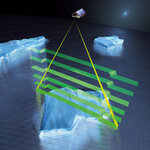Space
Thank goodness Bruce Willis is around, or the Midwest would have been a smoking crater this morning!
Authorities in several Midwestern states were flooded Wednesday night with reports of a gigantic fireball lighting up the sky, the National Weather Service said. Yes, gigantic fireball - although a few did say it could possibly be a meteor - but there was really no other way to describe the astronomical event.
Just after 10 p.m. on Wednesday night, folks across about 6 states in the Upper Midwest - Minnesota, Iowa, northern Missouri, Illinois, Indiana and Wisconsin - saw this and for some…

Through the study of a popular Martian meteorite's age, University of Houston researchers have uncovered important details about the history of volcanic activity on Mars.
ALH84001 is a thoroughly studied, well-known Martian meteorite, unique among Mars rocks available for study on Earth. Since its formation age is more than 2.5 billion years older than any other recognized Martian meteorite, it offers scientists the only view of Mars' early history. Data from this rock may also help geologists better understand, through analogy, the processes of early Earth evolution.
The new analysis of…

Could you successfully launch a high precision functioning space satellite that was made out of wood? Instead of speculating, I asked. In my 365DOA Podcast I called up Randa Milliron, the CEO of InterOrbital.com, aka the TubeSat people. Not only was she not scared away by the idea, but we got into a lively discussion on Steampunk in Space.
Now, she dubs her low-cost rocket venture ethos 'spacepunk', so we know we have a kindred spirit here. The interview was fun and, not to put too fine a point on it, just go listen to it (or read the transcript). The short answer, for…
Scientists assume that all exoplanets orbit in more or less the same plane and move along their orbits in the same direction of their host star's rotation. But now astronomers have discovered nine new exoplanets that may upset this conventional wisdom.
Researchers say that when combined with earlier observations of transiting exoplanets, the new images indicate that six out of a larger sample of 27 were found to be orbiting in the opposite direction to the rotation of their host star -- the exact reverse of what is seen in our own solar system.
After detecting the nine new exoplanets…
New images from the ESA's Herschel space observatory reveal the formation of previously unseen large stars that reside in the Rosette Nebula, each one up to ten times the mass of our Sun.
Astronomers say it is important to understand the formation of high-mass stars in our Galaxy because they feed so much light and other forms of energy into their parent cloud they can often trigger the formation of the next generation of stars.
The Rosette Nebula resides some 5,000 light years from Earth and is associated with a larger cloud that contains enough dust and gas to make the equivalent of 10,000…

Europe's first mission dedicated to studying the Earth's ice, CryoSat-2, was launched today from Kazakhstan. From its polar orbit, the satellite will send back data leading to new insights into how ice is responding to climate change and the role it plays in our 'Earth system'.
CryoSat-2 replaces the original CryoSat satellite that was lost in 2005 owing to a launch failure. The mission objectives, however, remain the same: to measure changes in the thickness of the vast ice sheets that overlie Antarctica and Greenland, as well as variations in the thickness of the relatively thin ice…
The Hubble space telescope has snapped a spectacular image of Messier 66, the largest "player" of the Leo Triplet, and a galaxy with an unusual anatomy: it displays asymmetric spiral arms and an apparently displaced core. The peculiar anatomy is most likely caused by the gravitational pull of the other two members of the trio. The unusual spiral galaxy, Messier 66, is located at a distance of about 35 million light-years in the constellation of Leo. Together with Messier 65 and NGC 3628, Messier 66 is one third of the Leo Triplet, a trio of interacting spiral galaxies, part of the larger…
Scientist with the European Space Agency (ESA) and NASA say that Venus is still geologically active. The Visible and Infrared Thermal Imaging Spectrometer (VIRTIS) aboard the ESA's Venus Express spacecraft has identified relatively young lava flows that suggests the planet remains capable of volcanic eruptions.
ESA researchers were able to determine the relative age of the flows based on how they react with Venus' atmosphere. On Earth, lava flows react rapidly with oxygen and other elements in the atmosphere, changing their composition. On Venus, the process should be similar, though…
Astronomers have directly observed the mysterious dark companion in the Epsilon Aurigae star system that has puzzled skywatchers since the 19th century.
Scientists captured close-up pictures of Epsilon Aurigae during its eclipse, which happens every 27 years. "Close up" in this case is a relative term, but the images zoom in enough to show the shape of the dark object's shadow. A new paper in Nature describes the images in detail.
Epsilon Aurigae is the fifth brightest star in the northern constellation Auriga. For more than 175 years, astronomers have known it is dimmer than it should be,…
Using the CRIRES instrument on ESOs Very Large Telescope, a team of astronomers have confirmed that summer is in full swing in the southern hemisphere of Neptune's largest moon Triton.
"We have found real evidence that the Sun still makes its presence felt on Triton, even from so far away. This icy moon actually has seasons just as we do on Earth, but they change far more slowly," says Emmanuel Lellouch, the lead author of the paper reporting these results in Astronomy&Astrophysics.
On Triton, where the average surface temperature is about minus 235 degrees Celsius, it is currently…